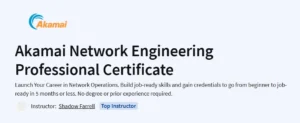What will you learn in Configuration Management Using Ansible Course
Understand Ansible and its application to managing configuration for remote hosts
Gain familiarity with Ansible architecture, including playbooks, inventory, modules, and plugins
Install and configure NGINX with Ansible—writing playbooks, working with tasks and handlers, and defining roles
Use variables, loops, conditional statements, and Jinja2 templating for dynamic configurations
Program Overview
Module 1: Getting Started
⏳ 10 minutes
Topics: Introduction to using Ansible for configuration management
Hands-on: Explore the interactive playground and run your first Ansible command
Module 2: What Is Configuration Management?
⏳ 30 minutes
Topics: Automated configurations, idempotency, and key management tools
Hands-on: Complete the quiz on configuration-management fundamentals
Module 3: Basics of Ansible
⏳ 1 hour 30 minutes
Topics: Control node vs. managed nodes, inventory setup, ad-hoc commands
Hands-on: Write an inventory file and execute ad-hoc tasks
Module 4: Major Concepts in Ansible
⏳ 1 hour
Topics: YAML, modules, tasks, playbooks, handlers, and roles
Hands-on: Create and run a simple playbook with handlers and a role
Module 5: Ansible Variables & Other Elements
⏳ 30 minutes
Topics: Variables, loops, conditionals, and Jinja2 templating
Hands-on: Write playbooks that leverage loops and templating for dynamic tasks
Module 6: Wrap Up
⏳ 10 minutes
Topics: Course summary and next steps
Hands-on: Deploy a sample web application using your playbooks
Get certificate
Job Outlook
DevOps Engineers specializing in configuration management earn an average of $129,066 per year in the U.S.
Automation and infrastructure-as-code skills are critical across cloud, enterprise IT, and startup environments
Roles include DevOps Engineer, Site Reliability Engineer, and Infrastructure Automation Specialist
Hands-on Ansible expertise opens freelance and full-time opportunities in system administration and CI/CD
Specification: Configuration Management Using Ansible Course
|
FAQs
- Ansible can configure resources across multiple cloud providers simultaneously.
- Supports AWS, Azure, Google Cloud, and on-premise servers.
- Playbooks can standardize deployments across diverse environments.
- Integrates with CI/CD pipelines for multi-cloud workflows.
- Reduces operational complexity by centralizing configuration management.
- Ansible supports encrypted variables with Vault for sensitive data.
- SSH keys are used for secure communication with remote nodes.
- Role-based access ensures only authorized users can execute tasks.
- Integrates with enterprise security policies and auditing systems.
- Regular updates and patching reduce vulnerabilities in automation scripts.
- Ansible playbooks automate app deployment, configuration, and updates.
- Works seamlessly with Jenkins, GitLab, and other CI/CD tools.
- Can roll back deployments automatically on failure.
- Supports version-controlled infrastructure for reproducibility.
- Reduces manual intervention, speeding up release cycles.
- Ansible is agentless, reducing maintenance overhead.
- Uses simple YAML syntax, easier for beginners than Ruby-based Chef.
- Strong integration with cloud and container platforms.
- Playbooks are idempotent, ensuring repeatable configurations.
- Faster setup and lower learning curve make it suitable for startups and enterprises alike.
- DevOps Engineer managing automated infrastructure.
- Site Reliability Engineer (SRE) optimizing production environments.
- Infrastructure Automation Specialist for enterprise IT.
- Freelance or consulting opportunities in configuration management.
- Cloud Engineer roles leveraging Ansible for scalable deployments.





